| URLs in this document have been updated. Links enclosed in {curly brackets} have been changed. If a replacement link was located, the new URL was added and the link is active; if a new site could not be identified, the broken link was removed. |
Use of the Paid Open Access Option in Hybrid Open Access Journals in Agriculture: A Mixed-Methods Study
Megan Kocher
Science Librarian
mkocher@umn.edu
Julie Kelly
Science Librarian
jkelly@umn.edu
University of Minnesota
St. Paul, Minnesota
Abstract
We explore the use and usefulness of the hybrid open access publishing model in agricultural sciences using a combination of quantitative and qualitative methods. To ascertain the level of usage of the paid open access option in hybrid open access journals in agriculture, we studied the agriculture-related journals published by six commercial publishers. These publishers offer authors the option of paying a fee, often close to $3,000 per article, to make their article immediately freely available, usually with a Creative Commons license. We defined agriculture broadly but also assigned each journal to a subspecialty (e.g., animal science) in order to see if there were differences based on these subdivisions. For each journal we gathered data for 2014-2015 and noted the total number of research articles and the number of those that were made freely available by authors paying the open access fee. To give context to our results we also surveyed local faculty in agricultural sciences, asking their reasons for considering the paid open access options and the sources of the funds to pay for it. Survey respondents were asked about their academic position and rank to see if there were differences to be noted. We also investigated the findability of the open access articles, noting if each individual publisher offered a way to easily locate all the freely available articles in a particular journal and if there are other avenues to easily locate these articles.
Background
Hybrid open access (OA) refers to a publishing model in which traditional subscription journals offer an option for authors to make their individual articles freely accessible by paying an additional fee. Other articles in the journal are only available through a subscription. This study looked at how many agricultural sciences researchers currently use the hybrid option, and what might be influencing their decision.
Various authors have covered the history of the hybrid OA movement (Bird & Richardson 2009; Björk 2012). The earliest adopters were societies that initially charged very low rates, with some tied to the cost of paper reprints. Some commercial publishers had plans to drop subscription rates as the utilization of hybrid OA grew, and one scenario for the future saw journals having such a high rate of authors paying for OA that journals would "flip" from hybrid to fully OA. The citation advantage of OA, now documented by many authors, was seen as a potential driver for uptake of hybrid OA (Wagner 2010).
Other factors influencing the decision whether to participate in hybrid open access, noted by Björk (2012), include price, availability of funds, mandates by granting agencies, the author's awareness of OA, the journal's policies concerning OA, whether OA articles are highlighted or easy to find, and the effort needed to complete the process. Although costs per article in hybrid OA hover around $3,000, a study of authors publishing in Proceedings of the National Academy of Sciences found that at $500, over 79% would be willing to participate, but when the costs rose to $1,500 only 2% expressed willingness (Cozzarelli et al. 2004).
Others have studied the rate of adoption of OA and in particular those articles in hybrid journals. In a 2010 study of hybrid journals from 12 publishers, Dallmeier-Tiessen and Goerner (2010) found a 2% uptake rate by authors, and in 2012 Björk (2012) surveyed a similar group and also found a rate of 2%. Bird and Richardson (2009) found an overall uptake of 7% for hybrid OA in 65 Oxford University Press journals in 2007, with percentages ranging from 2 to 11 for various disciplines. Laakso and Björk (2012) focused on "full immediate OA" journals but also recorded the number of hybrid OA and delayed OA articles (those that make all articles OA after a set embargo period) in journals indexed in Scopus and Web of Science.
Björk (2012) used a variety of methods to estimate the use of the OA option in hybrid journals, noting that it would be impossible to actually count the number of OA articles in the hundreds of hybrid journals. In this study, we selected one subject area, agriculture, and were able to conduct an exact count.
While the most obvious benefit of the hybrid OA option is the immediate and free availability of an individual paper, publishers may or may not include other rights. Suber (2006) lists "Nine questions for hybrid journal programs" which cover copyright, Creative Commons licenses, and the ability to repost on other sites.
One issue that has been noted by several authors is the lack of discoverability of the OA articles in hybrid journals (Björk 2012; Carpenter 2012; Chumbe et al. 2015). The issues range from lack of a large-scale, multi-publisher solution that could be used to find articles across publishers and disciplines to individual journals that mark OA articles in very subtle ways and thus make them difficult to locate. Carpenter (2012) states that "just providing OA options may not be sufficient to either authors, mandating institutions, libraries, or end users...." Chumbe (2015) describes a possible system where publishers utilize standard metadata elements that would allow an automated system to easily find the OA articles in hybrid journals.
There is no definitive answer about why authors choose to use the hybrid open access option or why they decide not to. There is much speculation that it is the high cost, and other possibilities include lack of awareness of the OA options or their benefits. Björk (2012) notes that "the only way to study that would be a massive Web survey of authors who had published in eligible journals and not used the hybrid opportunity."
Methods
This study consisted of two parts: A numerical analysis of hybrid open access use in agriculture journals and a survey of agricultural researchers on their hybrid open access practices.
Numerical Analysis
In order to obtain a high-level look at agricultural publishing, we performed general searches on agricultural topics in the broad science databases Web of Science and Scopus. We identified the top six publishers of agricultural journals that offered a hybrid open access option: Cambridge, Elsevier, Oxford, Springer, Taylor and Francis, and Wiley. For each publisher, we identified all agricultural journal titles that matched our pre-determined list of subject areas (see Appendix A) and were offered under their hybrid open access model. Journals were not included if they were entirely open access or offered no hybrid option. Further, journals were excluded if they were primarily trade- or news-oriented and did not include research articles. In total, 168 journals were included in the study. See Figure 1 for a breakdown of the percentage of journals included per publisher. For a full list of journals included, see Appendix B.
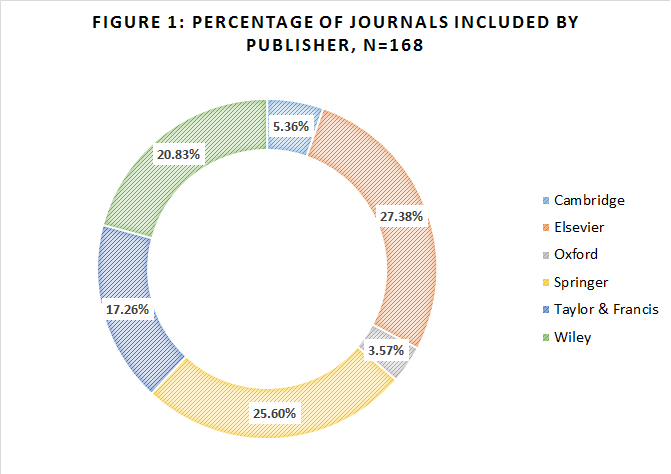
Each journal included was assigned a sub-specialty based on its primary area of focus. Those with a broad focus were assigned to a general agriculture category. For journals offering a range of fees for publishing open access articles, the highest fees were used. Using information provided on the journal web sites, we collected the following information about each journal:
- Total number of research articles published in 2014-2015.
- Total number of open access articles published in 2014-2015.
- Fee for publishing an open access article.
- A description of how to find open access articles on the journal web site.
Survey
In order to lend context to the numerical analysis, the authors developed a survey for agricultural researchers to determine their use of hybrid open access options and reasons for using or not using the option. The survey defined hybrid open access as "a publishing model in which traditional journals offer an option for authors to make their individual articles freely accessible to anyone worldwide, for an additional fee. Other articles in the journal remain accessible only through subscription" (MIT Libraries). The survey (see Appendix C) was created using Qualtrics software and was distributed via e-mail o all faculty in agriculture-related departments at the University of Minnesota in May 2016.
Results and Discussion
Numerical Analysis
In total, the included journals contained 46,373 research articles in 2014-2015. Of those, 2,137 (4.7%) were open access under a hybrid model. This is more than twice the rate found by Björk (2012) in a non-discipline-specific study of hybrid open access. Possible reasons for this difference are an increase in awareness and use of open access over time or a disciplinary difference in attitudes toward open access publishing.
Differences by Sub-discipline
While Bird and Richardson (2009), in their study of 65 Oxford Open journals, found an 11% rate of OA uptake for life sciences and 2% for social sciences and humanities, there are no comparable studies in agriculture that can be compared with the results of the current study. Figure 2 shows the percentage of open access articles published in each of the sub-disciplines identified in this study, and shows that two particular fields -- entomology (17.7%) and food systems (19.0%) -- have much higher rates of open access uptake in hybrid journals than other disciplines. This could indicate that even within agriculture, some sub-disciplines are more inclined towards open access publishing either because of attitudes or funding.
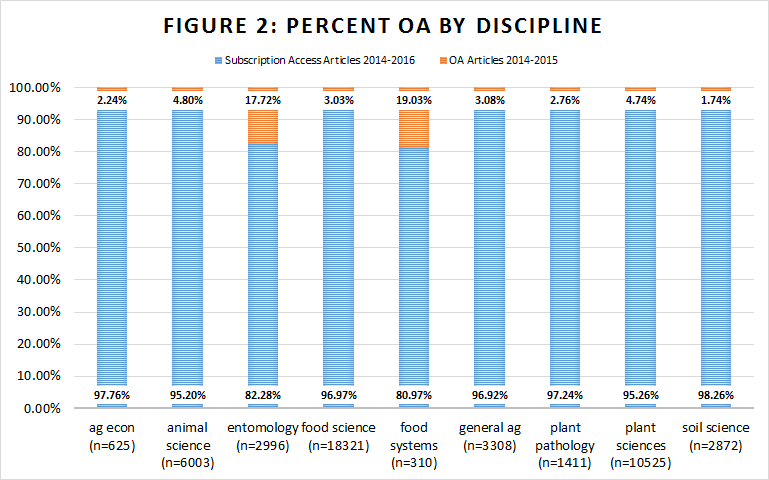
Differences by Publisher
We also looked at differences in hybrid open access use by publisher. Figure 3 shows that the percentage of open access articles published varied widely by publisher, from Cambridge's 0.2% to Oxford's 30.9%. One possible explanation may be found in how each publisher promotes the open access option to authors and in how visible OA articles are on their web sites.
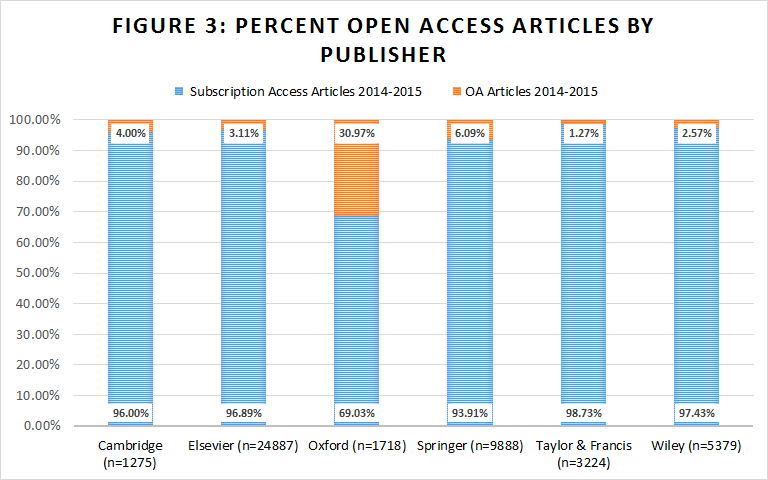
Table 1 is a breakdown of how the hybrid open access option is presented to authors and readers by each publisher. Most of the six publishers have information about OA linked from the main page of each journal. However, it is not always clear from that main page that the journal offers a paid OA option and the links are often not prominently displayed.

Only three of the six publishers provide an easy way to view a list of the all of the OA articles in an individual journal. Identifying whether individual articles are OA or not differs by publisher, and in many cases this is not particularly obvious when viewing an issue's table of contents. There may be a small open lock icon next to the title, "open access" in small font to one side of the citation, or a change in the color of another symbol. Most of these publishers also offer some "free" articles and it can be difficult to distinguish between the free and OA articles. It is easy to understand why there is concern about the discoverability of OA articles in hybrid journals.
The rights that authors retain when they select the OA option in a hybrid journal are often not as robust as those available in full OA journals. For example, authors may not retain the right to create derivative works. Among the six publishers in this study, all state that at least one Creative Commons license is available to the authors for most journals, depending on the wishes of a sponsoring organization. Springer has the most generous policy, with all articles assigned a CC BY license allowing reuse and immediate deposit of final article into any repository, plus an automatic export to PubMed Central. Others have varying stipulations about deposit in other repositories.
Cost
Figure 4 shows the average maximum cost to publish an open access article in a journal by publisher. The overall average cost per article is $2,919, and most publishers come very close to this. The exception is Oxford, whose average cost per article is $2,338. Oxford is also the publisher with the highest percentage of open access articles published, so this does suggest that price can be a factor in authors' decisions on whether or not to take advantage of a hybrid open access option.
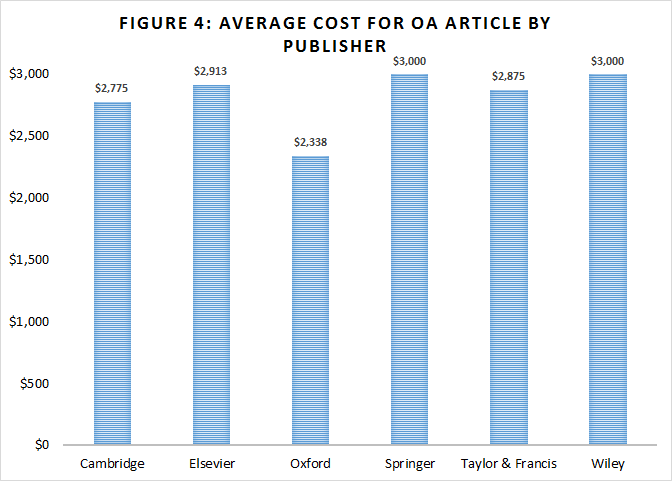
Survey
A total of 29 agriculture faculty completed the survey between April-May 2016. Their distribution by rank and department is shown in Table 2.

Use
Of the respondents, 68% reported that they had published in a journal that offers a hybrid open access option; 16% had not published in a hybrid open access journal; and 16% were unsure. Of those that had published in a hybrid journal, only eight (28% of total respondents) had ever paid for the open access option.
As indicated in our numerical analysis, Table 3 shows that the cost of publishing an open access article and the availability of funding were the top concerns of survey respondents in deciding whether or not to use this option. For those that did publish open access articles in hybrid journals, most made use of grant or departmental funding to cover the costs. Only one respondent reported using personal funds.

Redistribution
Since one of the advantages of publishing an open access journal is the ability to redistribute it, we asked survey respondents about their practices regarding this. The most common method of redistribution was publishing the article on a personal or departmental web site. Only one respondent indicated that they had made no effort to redistribute their articles. Significantly, no respondents indicated that they had deposited articles in a university or disciplinary repository.
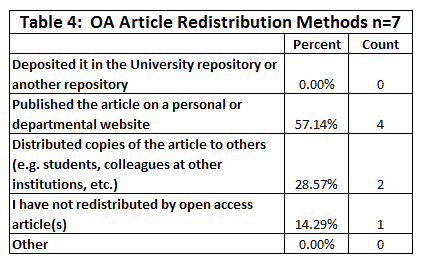
Conclusion
While larger than that in other disciplines, the 4.7% utilization rate of hybrid OA in agricultural journals is very low, especially compared to the predictions put forth by the publishers in the early days of hybrid OA (Björk 2012). High cost and lack of awareness may be contributing factors. Further research could delve more deeply into these and other potential reasons for the low use of hybrid OA.
Agriculture is similar to other disciplines in that relatively few researchers take advantage of the OA option when it is offered through a hybrid model. To get a fuller picture of OA publishing in this field, further research could determine the percentage of agricultural research articles published in fully-OA versus hybrid publications.
The implications for librarians are several: First, we need to raise awareness about the importance and advantages of open access publishing. Second, we need to advocate for other models of open access publishing that result in greater use than the hybrid model -- this includes supporting low-cost, fully-OA journals. Finally, we need to help researchers overcome hurdles with OA publishing and sharing their articles both by assisting with or finding funding for open access costs, and by facilitating easier ways of sharing articles through institutional repositories and other venues.
References
Bird, C. & Richardson, M. 2009. Publishing journals under a hybrid subscription and open access model. In: Cope, B. & Phillips, A., editors. The future of the academic journal. Oxford: Chandos Publishing. p. 139-146.
Björk, B-C. 2012. The hybrid model for open access publication of scholarly articles: a failed experiment? Journal of the American Society for Information Science and Technology 63(8):1496-1504. doi: 10.1002/asi.22709
Carpenter, T.A. 2012. As hybrid open access grows, the scholarly community needs article-level OA metadata. Scholarly Kitchen [Internet]. [Cited 2016 June 28]. Avaliable from: https://scholarlykitchen.sspnet.org/2012/12/05/as-hybrid-open-access-grows-the-scholarly-community-needs-article-level-oa-metadata/
Chumbe, S., Kelly, B. & MacLeod, R. 2015. Hybrid journals: ensuring systematic and standard discoverability of the latest open access articles. Serials Librarian 68:143-155. doi: 10.1080/0361526X.2015.1016856
Cozzarelli, N.R., Fulton, K.R. & Sullenberger, D.M. 2004. Results of a PNAS author survey on an open access option for publication. Proceedings of the National Academy of Sciences of the U.S.A. 101(5):1111. doi: 10.1073/pnas.0307315101
Dallmeier-Tiessen, S., Goerner, B., Darby, R., Hyppoelae, J., Igo-Kemenes, P., Kahn, D., Lambert, S., Lengenfelder, A., Leonard, C., Mele, S., Polydoratou, P., Ross, D., Ruiz-Perez, S., Schimmer, R., Swaisland, M. & van der Stelt, W. 2010. Open access publishing -- models and attributes. [Cited 2016 June 28]. Available from http://hdl.handle.net/11858/00-001M-0000-0013-838A-6
Laakso, M. & Björk, B-C. 2012. Anatomy of open access publishing: a study of longitudinal development and internal structure. BMC Medicine 10(124). doi: 10.1186/1741-7015-10-124
MIT Libraries. Scholarly Publishing - MIT Libraries | hybrid journals [Internet]. [Cited 2016 May 17]. Available from: {http://web.archive.org/web/20141226230612/http://libraries.mit.edu/scholarly/hybrid-journals}
Suber, P. 2006. Nine questions for hybrid journal programs. SPARC Open Access Newsletter [Internet]. [Cited 2016 October 25] 101. Available from: http://legacy.earlham.edu/~peters/fos/newsletter/09-02-06.htm
Wagner, A.B. 2010. Open access citation advantage: an annotated bibliography. Issues in Science and Technology Librarianship 60. doi: 10.5062/F4Q81B0W
Appendix A: Subject Area List
- Agronomy
- Animal Science
- Agricultural Economics
- Entomology
- Food Science
- Food Systems
- Forestry
- General Agriculture
- Horticulture
- Land Use
- Plant Pathology
- Soils
Appendix B: Journals Included by Publisher
Cambridge
- Animal
- Bulletin of Entomological Research
- Experimental Agriculture
- International Journal of Tropical Insect Science
- Journal of Agricultural Science
- Journal of Applied Animal Nutrition
- Plant Genetic Resources
- Renewable Agriculture and Food Systems
- Seed Science Research
Elsevier
- Agricultural and Forest Meteorology
- Agricultural Systems
- Agricultural Water Management
- Agriculture, Ecosystems & Environment
- Animal Behaviour
- Animal Feed Science and Technology
- Animal Reproduction Science
- Applied Soil Ecology
- Biocatalysis and Agricultural Biotechnology
- Computers and Electronics in Agriculture
- Crop Protection
- Engineering in Agriculture, Environment and Food
- European Journal of Agronomy
- Field Crops Research
- Food and Bioproducts Processing
- Food and Chemical Toxicology
- Food Bioscience
- Food Chemistry
- Food Control
- Food Hydrocolloids
- Food Microbiology
- Food Packaging and Shelf Life
- Food Policy
- Food Quality and Preference
- Food Research International
- Food Structure
- Global Food Security
- Industrial Crops and Products
- Innovative Food Science and Emerging Technologies
- International Dairy Journal
- International Journal of Food Microbiology
- Journal of Applied Research on Medicinal and Aromatic Plants
- Journal of Cereal Science
- Journal of Dairy Science
- Journal of Food Composition and Analysis
- Journal of Food Engineering
- Journal of Functional Foods
- Livestock Science
- LWT- Food Science and Technology
- Meat Science
- Pesticide Biochemistry and Physiology
- Postharvest Biology and Technology
- Scientia Horticulturae
- Soil and Tillage Research
- Soil Biology & Biochemistry
- Trends in Food Science & Technology
Oxford
- American Journal of Agricultural Economics
- Annals of the Entomological Society of America
- European Review of Agricultural Economics
- Journal of Applied Poultry Research
- Journal of Insect Science
- Poultry Science
Springer
- Agronomy for Sustainable Development
- American Journal of Potato Research
- Arthropod-Plant Interactions
- Australasian Plant Pathology
- BioEnergy Research
- Biology and Fertility of Soils
- Economic Botany
- Entomological Review
- Erwerbs-Obstbau
- European Food Research and Technology
- European Journal of Plant Pathology
- Food Analytical Methods
- Food and Bioprocess Technology
- Food and Environmental Virology
- Food Biophysics
- Food Engineering Reviews
- Food Security
- Genetic Resources and Crop Evolution
- Gesunde Pflanzen
- Irrigation Science
- Journal of Applied Phycology
- Journal of Food Science and Technology
- Journal of General Plant Pathology
- Journal of Insect Behavior
- Journal of Pest Science
- ournal of Plant Growth Regulation
- Journal of Plant Research
- Journal of Soils and Sediments
- Molecular Breeding
- Nutrafoods
- Nutrient Cycling in Agroecosystems
- Organic Agriculture
- Paddy and Water Environment
- Phytoparasitica
- Plant Biotechnology Reports
- Plant Cell, Tissue and Organ Culture (PCTOC)
- Plant Molecular Biology
- Plant Systematics and Evolution
- Planta
- Potato Research
- Precision Agriculture
- Probiotics and Antimicrobial Proteins
- Theoretical and Applied Genetics
Taylor & Francis
- Acta Agriculturae Scandinavica, Section A -- Animal Science
- Acta Agriculturae Scandinavica, Section B -- Soil & Plant Science
- African Journal of Range & Forage Science
- Agrekon: Agricultural Economics Research, Policy and Practice in Southern Africa
- Archives of Agronomy and Soil Science
- Archives of Animal Nutrition
- Archives Of Phytopathology And Plant Protection
- Biocontrol Science and Technology
- Biological Agriculture & Horticulture: An International Journal for Sustainable Production Systems
- British Poultry Science
- Canadian Journal of Plant Pathology
- Critical Reviews in Food Science and Nutrition
- East African Agricultural and Forestry Journal
- Food and Agricultural Immunology
- Food Reviews International
- GM Crops & Food: Biotechnology in Agriculture and the Food Chain
- International Journal of Acarology
- International Journal of Agricultural Sustainability
- International Journal of Food Sciences and Nutrition
- International Journal of Fruit Science
- International Journal of Pest Management
- International Journal of Vegetable Science
- Journal of Crop Improvement
- Journal of Environmental Science and Health, Part B: Pesticides, Food Contaminants, and Agricultural Wastes
- Journal of International Food & Agribusiness Marketing
- Journal of Natural Fibers
- New Zealand Entomologist
- New Zealand Journal of Agricultural Research
- New Zealand Journal of Crop and Horticultural Science
Wiley
- Agribusiness
- Agricultural and Forest Entomology
- Animal Genetics
- Animal Science Journal
- Austral Entomology
- Australian Journal of Agricultural and Resource Economics
- Australian Journal of Grape and Wine Research
- Biofuels, Bioproducts and Biorefining
- Canadian Journal of Agricultural Economics/Revue canadienne d'agroeconomie
- Culture, Agriculture, Food and Environment
- Entomologia Experimentalis et Applicata
- Entomological Research
- Entomological Science
- EPPO Bulletin
- EuroChoices
- European Journal of Soil Science
- Grass and Forage Science
- Grassland Science
- Insect Science
- Irrigation and Drainage
- Journal of Agricultural Economics
- Journal of Agronomy and Crop Science
- Journal of Animal Breeding and Genetics
- Journal of Animal Physiology and Animal Nutrition
- Journal of Applied Entomology
- Journal of Food Biochemistry
- Journal of Plant Nutrition and Soil Science
- Journal of the Science of Food and Agriculture
- Land Degradation & Development
- Molecular Nutrition & Food Research
- Pest Management Science
- Soil Use and Management
- Systematic Entomology
- Weed Biology and Management
- Weed Research
Appendix C: Survey Questions
- 1. Have you published in a journal that offers a hybrid open access option?
- a. Yes
- b. No
- c. I am unsure
- 2. (If a. or c. to Question 1) Have you ever paid for the open access option when publishing in a hybrid open access journal?
- a. Yes
- b. No
- 3. (If a. to Question 2) What sources of funding have you used to pay for making an article open access? [Check all that apply.]
- a. Grant Funds
- b. Departmental Funds
- c. University's Open Access Publishing Fund
- d. Personal Funds
- e. Other
- 4. (If a. to Question 2) Which (if any) of the following methods have you used to redistribute your open access article(s)? [Check all that apply.]
- a. Deposited it in the University repository or another repository
- b. Published the article on a personal or departmental web site
- c. Distributed copies of the article to others (e.g. students, colleagues at other institutions, etc.)
- d. I have not redistributed my open access article(s)
- e. Other
- 5. When publishing in a journal that offers a hybrid open access option for authors, what influences (positively or negatively) your decision on whether or not to pay for the open access option? [Check all that apply.]
- a. Cost
- b. Availability of funding
- c. Commitment to open access publishing
- d. Opinions/influence from co-authors
- e. Other
- 6. What is your primary department affiliation
- a. Animal Science
- b. Applied Economics
- c. Agricultural Education
- d. Agronomy and Plant Genetics
- e. Bioproducts and Biosystems Engineering
- f. Entomology
- g. Fisheries, Wildlife and Conservation Biology
- h. Food Science and Nutrition
- i. Forest Resources
- j. Horticultural Science
- k. Plant Pathology
- l. Soil, Water and Climate
- m. Other
- 7. What is your current position?
- a. Assistant Professor
- b. Associate Professor
- c. Full Professor
- d. Other
| Previous | Contents | Next |

This work is licensed under a Creative Commons Attribution 4.0 International License.
